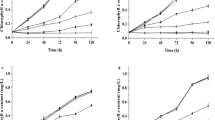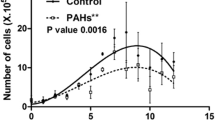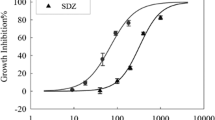Abstract
The toxic effects of p-xylene, 4-methylbenzyl alcohol, p-methyl benzaldehyde, and p-toluic acid on two marine microalgae (Phaeodactylum tricornutum Bohlin, and Skeletonema costatum) were investigated. p-Xylene was the most toxic to Pha. tricornutum with a 96 h EC50 value of 6.76 mg L−1. Based on the 96 h EC50 values for two microalgae, the toxicity of the four chemicals, in descending order, was: p-xylene, p-methyl benzaldehyde, 4-methylbenzyl alcohol, then p-toluic acid. The results showed that the toxicity of the transformed products of p-xylene was lower than that of p-xylene.

Similar content being viewed by others
References
Benville PE, Korn S (1977) The acute toxicity of six monocyclic aromatic crude oil components to striped bass (Morone saxatilis) and bay shrimp (Crago franciscorum). Calif Fish Game 63(4):204–209
Cunha I, Moreira S, Santos MM (2015) Review on hazardous and noxious substances (HNS) involved in marine spill incidents—an online database. J Hazard Mater 285:509–516
Cushman JR, Rausina GA, Cruzan G, Gilbert J, Williams E, Harrass MC, Sousa JV, Putt AE, Garvey NA, St Laurent JP, Hoberg JR, Machdo MW (1997) Ecotoxicity hazard assessment of styrene. Ecotoxicol Environ Saf 37(2):173–180
Di Marzio W, Saenz ME (2004) Quantitative structure-activity relationship for aromatic hydrocarbons on freshwater fish. Ecotoxicol Environ Saf 59(2):256–262
Duan W, Meng F, Lin Y, Wang G (2017a) Toxicological effects of phenol on four marine microalgae. Environ Toxicol Pharm 52:170–176
Duan W, Meng F, Wang F, Liu Q (2017b) Environmental behavior and eco-toxicity of xylene in aquatic environments: a review. Ecotoxicol Environ Saf 145:324–332
Duan W, Meng F, Peng X, Lin Y, Wang G, Wu J (2019) Kinetic analysis and degradation mechanism for natural attenuation of xylenes under simulated marine conditions. Ecotoxicol Environ Saf 168:443–449
Ehrhardt M (1987) Photo-oxidation products of fossil fuel components in the water of Hamilton Harbour Bermuda. Mar Chem 22(1):85–94
Finney DJ (1971) Probit analysis, 3rd edn. Cambridge University Press, New York
Galassi S, Mingazzini M, Vigano L, Cesareo D, Tosato ML (1988) Approaches to modeling toxic responses of aquatic organisms to aromatic hydrocarbons. Ecotoxicol Environ Saf 16(2):158–169
GESAMP (2013) Revised GESAMP hazard evaluation procedure for chemical substances carried by ships, 2nd edn. International Maritime Organization, London
Goldman JC, Dennett MR, Riley CB (1982) Effect of nitrogen-mediated changes in alkalinity on pH control and CO2 supply in intensive microalgal cultures. Biotechnol Bioeng 24(3):619–631
Guillard RRL (1975) Culture of phytoplankton for feeding marine invertebrates. In: Smith WL, Chanley MH (eds) Culture of marine invertebrate animals. Plenum Press, New York, pp 26–60
Guillard RR, Ryther JH (1962) Studies of marine planktonic diatoms: I. Cyclotella nana Hustedt, and Detonula confervacea (Cleve) Gran. Can J Microbiol 8(2):229–239
Hutchinson TH, Scholz N, Guhl W (1998) Analysis of the ECETOC aquatic toxicity (EAT) database IV—comparative toxicity of chemical substances to freshwater versus saltwater organisms. Chemosphere 36(1):143–153
ITOPF (2011) Techical Information Paper (TIP 17): Response to marine chemical incidents. The International Tanker Owners Pollution Federation. https://www.itopf.org/knowledge-resources/documents-guides/document/tip-17-response-to-marine-chemical-incidents/. Accessed 26 Jan 2019
Kim S, Chen J, Cheng T, Gindulyte A, He J, He S, Li Q, Shoemaker BA, Thiessen PA, Yu B, Zaslavsky L, Zhang J, PubChem Bolton EE (2019) update: improved access to chemical data. Nucleic Acids Res 47(D1):D1102–1109. https://doi.org/10.1093/nar/gky1033
Kini S, Kulkarni SD, Ganiga V, Nagarakshit TK, Chidangil S (2019) Dual functionalized, stable and water dispersible CdTe quantum dots: facile, one-pot aqueous synthesis, optical tuning and energy transfer applications. Mater Res Bull 110:57–66
MacLean MM, Doe KG (1989) The comparative toxicity of crude and refined oils to Daphnia magna and Artemia. Environment Canada, Environmental Protection Directorate, River Road Environmental Technology Centre
Mazzeo DEC, Levy CE, de Angelis DDF, Marin-Morales MA (2010) BTEX biodegradation by bacteria from effluents of petroleum refinery. Sci Total Environ 408(20):4334–4340
McFarland JW (1970) Parabolic relation between drug potency and hydrophobicity. J Med Chem 13(6):1192–1196
Neuparth T, Capela R, Pereira SPP, Moreira SM, Santos MM, Reis-Henriques MA (2014) Toxicity effects of hazardous and noxious substances (HNS) to marine organisms: acute and chronic toxicity of p-xylene to the amphipod Gammarus locusta. J Toxicol Environ Health A 77(20):1210–1221
Peng C, Lee JW, Sichani HT, Ng JC (2015) Toxic effects of individual and combined effects of BTEX on Euglena gracilis. J Hazard Mater 284:10–18
Schultz TW, Bryant SE, Kissel TS (1996) Toxicological assessment in tetrahymena of intermediates in aerobic microbial transformation of toluene and p-xylene. B Environ Contam Toxicol 56(1):129–134
USEPA (2012) Ecological effects test guidelines OCSPP 850.4500:Algal Toxicity. EPA 712-C-006
Acknowledgements
This work was supported by the National Marine Hazard Mitigation Service, Ministry of Natural Resources of the People’s Republic of China through its Commissioned Research Scheme (Grant No. 2018AA019).
Author information
Authors and Affiliations
Corresponding author
Rights and permissions
About this article
Cite this article
Li, F., Duan, W., Du, S. et al. Toxicological Assessment of Intermediates in Natural Attenuation of p-Xylene to Marine Microalgae. Bull Environ Contam Toxicol 103, 441–446 (2019). https://doi.org/10.1007/s00128-019-02646-6
Received:
Accepted:
Published:
Issue Date:
DOI: https://doi.org/10.1007/s00128-019-02646-6




